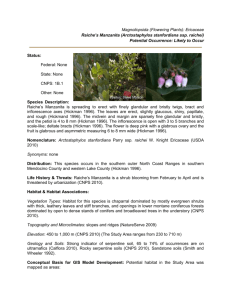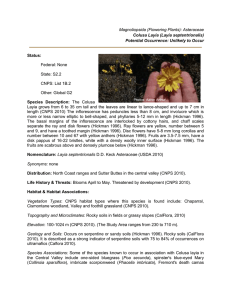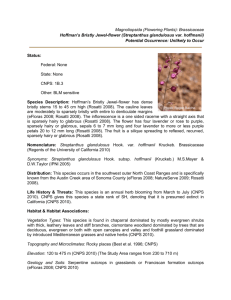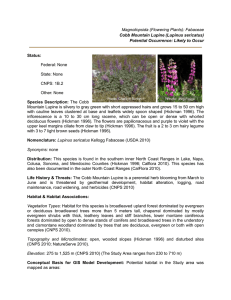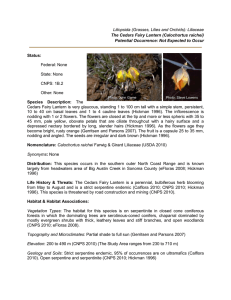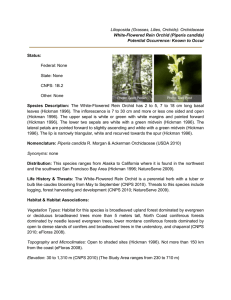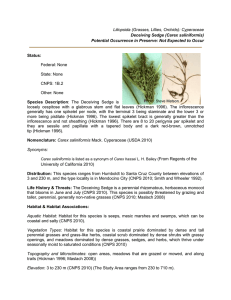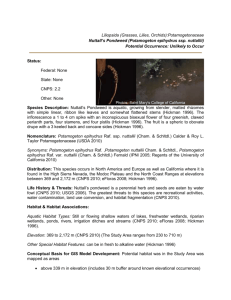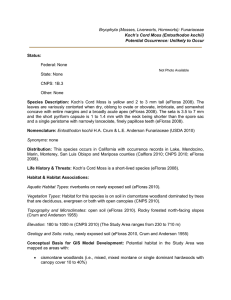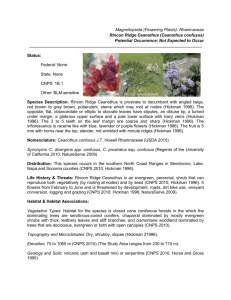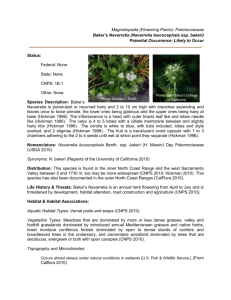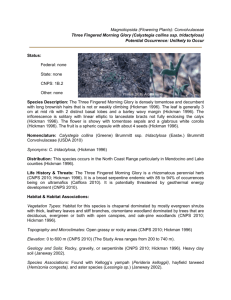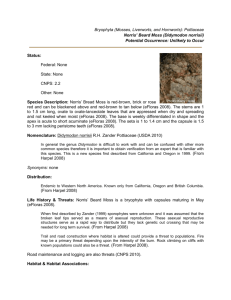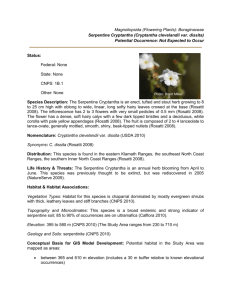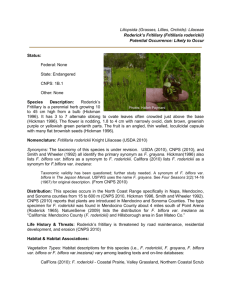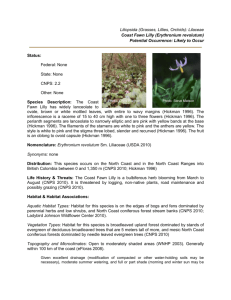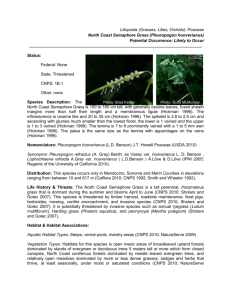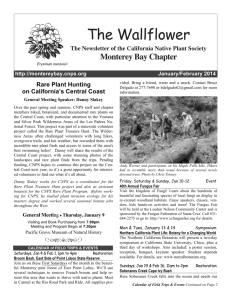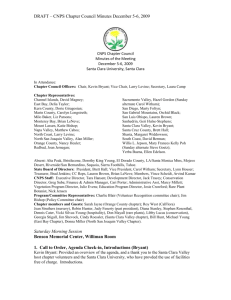b - Sonoma State University
advertisement
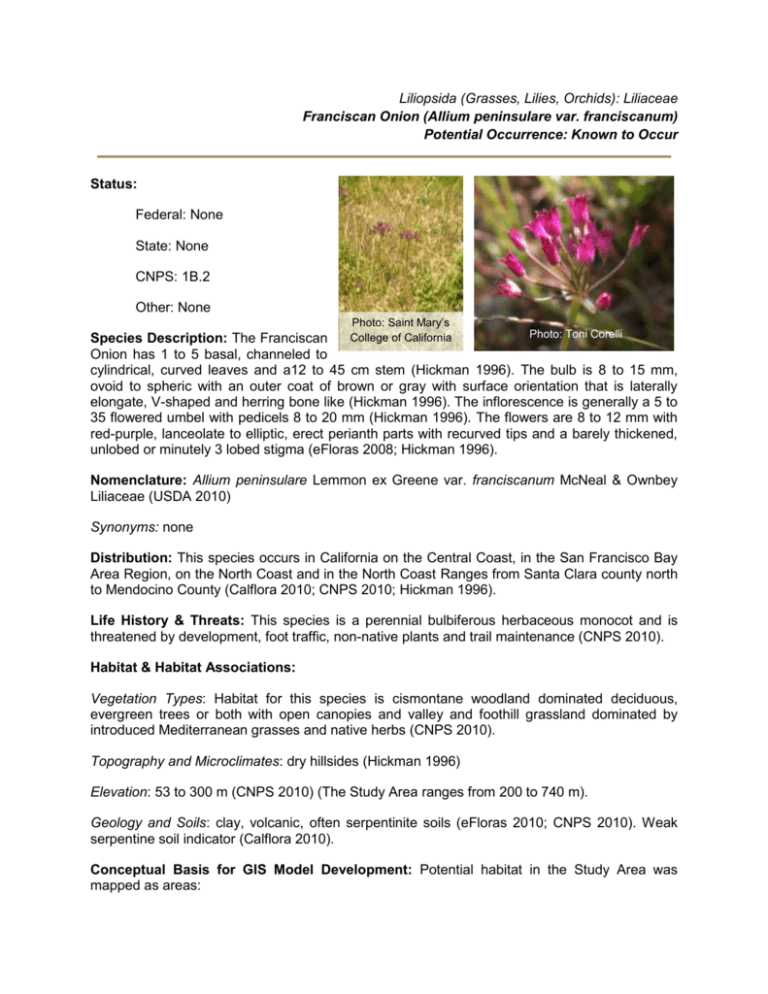
Liliopsida (Grasses, Lilies, Orchids): Liliaceae Franciscan Onion (Allium peninsulare var. franciscanum) Potential Occurrence: Known to Occur Status: Federal: None State: None CNPS: 1B.2 Other: None Photo: Saint Mary’s Photo: Toni Corelli College of California Species Description: The Franciscan Onion has 1 to 5 basal, channeled to cylindrical, curved leaves and a12 to 45 cm stem (Hickman 1996). The bulb is 8 to 15 mm, ovoid to spheric with an outer coat of brown or gray with surface orientation that is laterally elongate, V-shaped and herring bone like (Hickman 1996). The inflorescence is generally a 5 to 35 flowered umbel with pedicels 8 to 20 mm (Hickman 1996). The flowers are 8 to 12 mm with red-purple, lanceolate to elliptic, erect perianth parts with recurved tips and a barely thickened, unlobed or minutely 3 lobed stigma (eFloras 2008; Hickman 1996). Nomenclature: Allium peninsulare Lemmon ex Greene var. franciscanum McNeal & Ownbey Liliaceae (USDA 2010) Synonyms: none Distribution: This species occurs in California on the Central Coast, in the San Francisco Bay Area Region, on the North Coast and in the North Coast Ranges from Santa Clara county north to Mendocino County (Calflora 2010; CNPS 2010; Hickman 1996). Life History & Threats: This species is a perennial bulbiferous herbaceous monocot and is threatened by development, foot traffic, non-native plants and trail maintenance (CNPS 2010). Habitat & Habitat Associations: Vegetation Types: Habitat for this species is cismontane woodland dominated deciduous, evergreen trees or both with open canopies and valley and foothill grassland dominated by introduced Mediterranean grasses and native herbs (CNPS 2010). Topography and Microclimates: dry hillsides (Hickman 1996) Elevation: 53 to 300 m (CNPS 2010) (The Study Area ranges from 200 to 740 m). Geology and Soils: clay, volcanic, often serpentinite soils (eFloras 2010; CNPS 2010). Weak serpentine soil indicator (Calflora 2010). Conceptual Basis for GIS Model Development: Potential habitat in the Study Area was mapped as areas: below 330 m in elevation (includes a 30 m buffer on known elevational occurrences of this species) grasslands or cismontane woodlands (i.e. mixed, montane mixed and single dominant hardwoods vegetation types with canopy cover between 10 and 40%) We additionally identified as best potential habitat as: clay soils (i.e. clay loam) on dry hillsides (south, southwest, or southeast facing slopes with > 7 degree slope) Serpentine soils, while common regionally, are not indicated by the GIS soil data as occurring in the Study Area. To verify the GIS information, we identified all areas (11 sites) of exposed rocky soils from high-resolution satellite imagery. During site visits to these areas, the only serpentine found were rocks exposed by road maintenance activity at a waterbar. Volcanic soils are not present in the Study Area. Potential Occurrence in the Galbreath Wildlands Preserve: Habitat: The best habitat for Franciscan Onion in the Preserve is predominantly cismontane woodlands with clay soils below 330 m. This type of habitat is limited in the Galbreath Wildlands Preserve, occurring predominantly along portions of Rancheria Creek and its tributaries. The best soils are located along Levingston Creek. Habitat quality is moderate to good. Franciscan Onion is weakly associated with serpentine soils and with volcanic soils, both of which do not occur in the Preserve. However, the sites with clay soils may provide high quality habitat for this species. Nearest Occurrence: Documented Occurrences in the Galbreath Wildlands Preserve: Franciscan Onion was found at 4 roadside sites (~1300 individuals) in southern and central areas of the Preserve in 2013 (Geri Hulse-Stevens, and Kerry Heise, pers. comm; location and abundance data available from SSU Preserve staff). Note that these data are not shown on the attached map. Nearest Occurrence the Galbreath Wildlands Preserve: Franciscan Onion was known previously from 1 occurrence in Mendocino County, the most northern reported occurrence for this species. It is more common to the south in Sonoma County (15 occurrences) and counties south of San Francisco (Calflora 2010). Literature reports indicate that the species is rare but widespread throughout Sonoma County. The nearest documented occurrence to the Preserve is 11 miles to the east in the upper reaches of the Middle Russian River watershed (Calflora 2010). Summary: This species is “Known to Occur” on the Preserve. References Calflora. 2010. Information on California plants for education, research and conservation. <http://www.calflora.org/> Accessed 2010 Jun 28. California Native Plant Society (CNPS). 2010. Inventory of Rare and Endangered Plants. Online edition, v7-10b. <http://www.cnps.org/inventory> Accessed 2010 Jun 28. Corelli T. 2007. Allium peninsulare var. franciscanum. <http://calphotos.berkeley.edu/cgibin/img_query?rel-taxon=contains&where-taxon=Allium+peninsulare+var.+franciscanum>. Accessed 2010 Nov 2. eFloras 2008. Flora of North America.<http://www.efloras.org>. Accessed 2010 Jun 28. Hickman JC editor. 1996. The Jepson Manual Higher Plants of California. 3rded. London: University of California Press, Ltd. 1178 p. Saint Mary’s College of California. 1995. Allium peninsulare var. franciscanum. <http://calphotos.berkeley.edu/cgi-bin/img_query?rel-taxon=contains&wheretaxon=Allium+peninsulare+var.+franciscanum>. Accessed 2010 Nov 2. Schneider L. 2010. Personal communication. 2010 Jun 12. SSU Field Stations and Nature Preserves. 2010. Galbreath Wildlands Preserve Vascular Plant List. <http://www.sonoma.edu/preserves/docs/galbreath_vascular_plants.pdf>. Accessed 2010 Jun. United States Department of Agriculture (USDA). 2010. PLANTS Profile. <http://plants.usda.gov/java/nameSearch?mode=symbol&keywordquery=ALPEF>. Accessed 2010 Oct 4. Species Account Description: Linden Schneider
